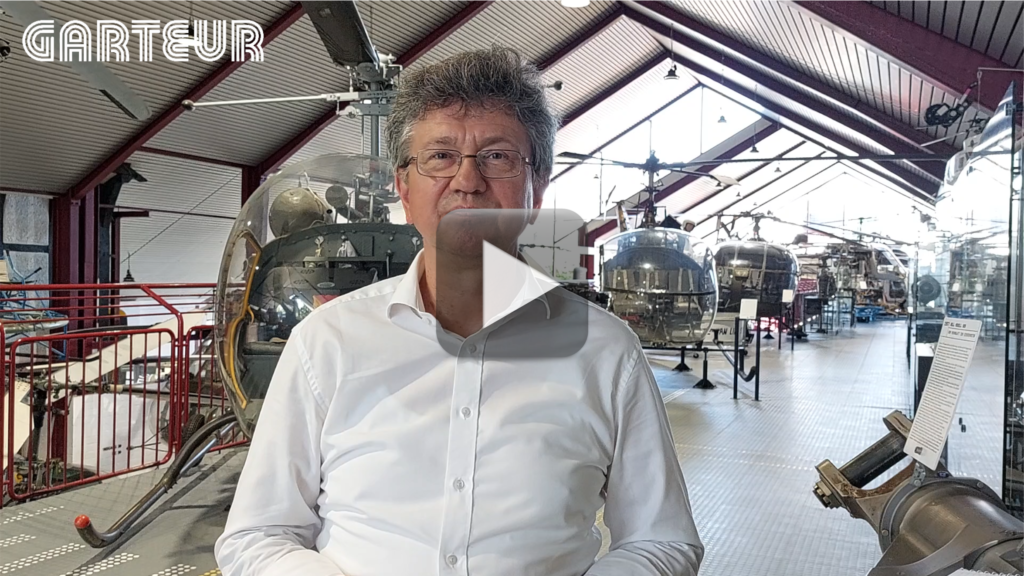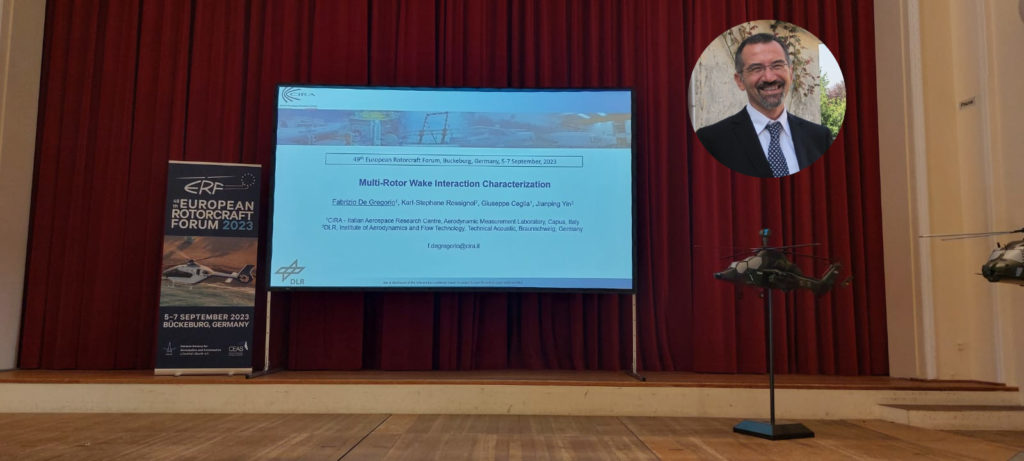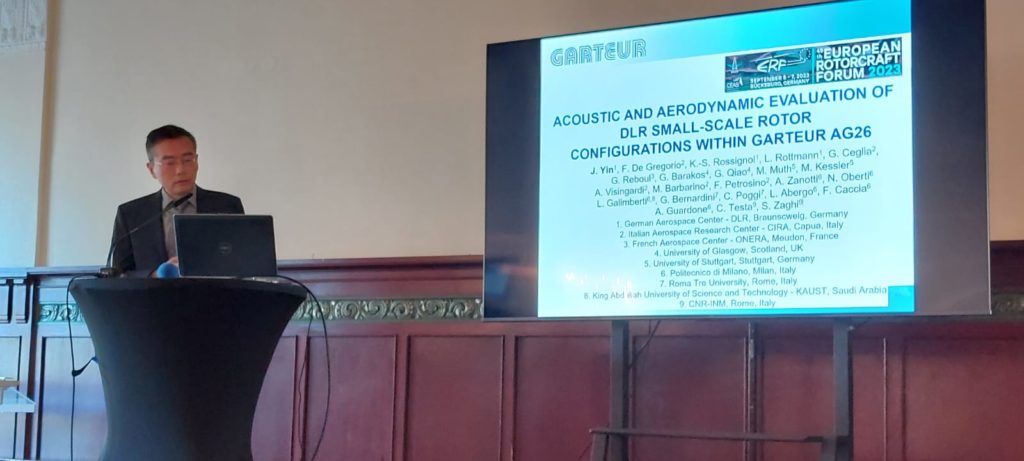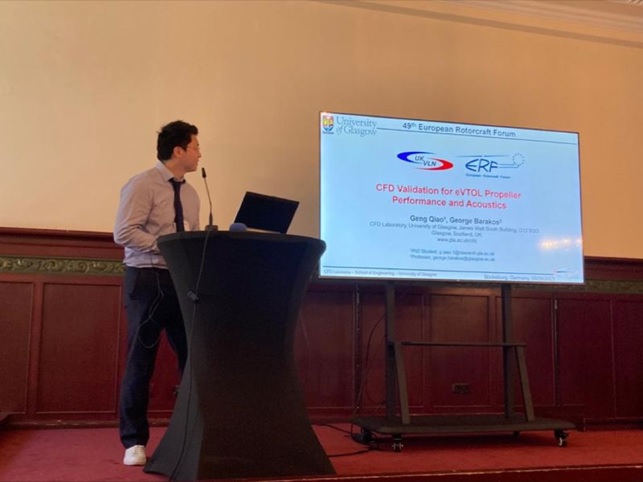GARTEUR rotorcraft research activities showcased at ERF23
The 49th Annual European Rotorcraft Forum (#ERF2023) held in Bückeburg, Germany on 5-7 September 2023, was an occasion for GARTEUR to showcase some of its most recent research activities in the rotorcraft sector.
Klausdieter Pahlke, Chairman of the Programme Committee of the ERF2023, and historical member of the GARTEUR Rotorcraft Group of Responsables, kindly gave a brief overview of the trends in the rotocraft sector and the role played by GARTEUR.

Interview given by Klausdieter Pahlke, Chairman of the Programme Committee of the ERF2023, and historical member of the GARTEUR Rotorcraft Group of Responsables
Two of the papers presented regarded research activities carried out directly in GARTEUR:

Presentation about “MULTI-ROTOR WAKE INTERACTION CHARACTERIZATION”
MULTI-ROTOR WAKE INTERACTION CHARACTERIZATION
De Gregorio¹, K.-S. Rossignol², G. Ceglia¹, J. Yin²;
¹ Italian Aerospace Research Center – CIRA, Capua, Italy,
² German Aerospace Center – DLR, Braunschweig, Germany
“The paper presents part of the experimental activities carried out in the GARTEUR Action Group HC/AG-26 to study the acoustic and aerodynamic characteristics of small rotor configurations, including the influence of the rotor-rotor interactions. Two rotors equipped with two-bladed propellers with a diameter of D=165.1mm were used at two different rotating speeds of 8025 RPM and 10120 RPM and different geometry configurations. Isolated rotor and coaxial configurations in hover conditions were assessed. The rotor slipstream characterization, in terms of aerodynamic loads, flow field velocity and acoustics emissions, was performed using a six-component load cell, Particle Image Velocimetry and microphone array measurements. The effect of the rotor support/fairing on the performance of the isolated rotor was investigated together with the rotor-rotor interaction for the coaxial configuration at two rotor distances of Δz = 0.5R and Δz = 1.0 R. The results indicated an effect of the support/fairing on the propeller performance, a loss of thrust of the lower rotor and a higher noise emission for the coaxial configuration characterized by the larger rotor distance. The turbulent kinetic energy and the meandering of the blade tip vortices sustained the acoustics results.”

Presentation about “ACOUSTIC AND AERODYNAMIC EVALUATION OF DLR SMALL-SCALE ROTOR CONFIGURATIONS WITHIN GARTEUR AG26”
ACOUSTIC AND AERODYNAMIC EVALUATION OF DLR SMALL-SCALE ROTOR CONFIGURATIONS WITHIN GARTEUR AG26
Yin1, F. De Gregorio2, K.-S. Rossignol1, L. Rottmann1, G. Ceglia2, G. Reboul3, G. Barakos4, G. Qiao4, M. Muth5, M. Kessler5, A. Visingardi2, M. Barbarino2, F. Petrosino2, A. Zanotti6, N. Oberti6, L. Galimberti6, 8, G. Bernardini7, C. Poggi7, L. Abergo6, F. Caccia6, A. Guardone6, C. Testa9, S. Zaghi9
1 German Aerospace Center – DLR, Braunschweig, Germany,
2 Italian Aerospace Research Center – CIRA, Capua, Italy,
3 French Aerospace Center – ONERA, Meudon, France,
4 University of Glasgow, Scotland, UK,
5 University of Stuttgart, Stuttgart, Ge,rmany,
6 Politecnico di Milano, Milan, Italy
7 Roma Tre University, Rome, Italy,
8 King Abdullah University of Science and Technology – KAUST, Saudi Arabia,
9 CNR-INM, Rome, Italy
“This paper presents the activities performed in the GARTEUR Action Group HC/AG-26 to study the acoustic and aerodynamic characteristics of small rotor configurations, including the influence of the rotor-rotor interactions. This paper will focus on comparisons between numerical activities and wind tunnel results on a small rotor provided by DLR. The wind tunnel models included a Rotor/Rotor/Pylon in isolated, tandem and coaxial configuration. The wind tunnel experiments for acoustics were performed in DLR’s Acoustic Wind Tunnel Braunschweig (AWB) and PIV test were performed in CIRA within a joint CIRA/DLR test program. For simulations, the numerical approaches from each partner are applied. The aerodynamic simulations necessary for the aeroacoustic predictions are conducted with various fidelity numerical methods, varying from lifting line to CFD. The acoustic values on the microphone positions are evaluated using Ffowcs Williams-Hawking (FW-H) formulation by all partners. The acoustic and aerodynamic predictions are compared to test data, including performance, PIV and acoustic directivity.”
While a third paper used experimental data produced within GARTEUR

Presentation about “CFD VALIDATION FOR EVTOL PROPELLER PERFORMANCE AND ACOUSTICS”
CFD VALIDATION FOR EVTOL PROPELLER PERFORMANCE AND ACOUSTICS
- Qiao¹, G.N. Barakos¹; ¹University of Glasgow, GB
“Research in aerodynamically generated noise attracts significant interest from industry, academia, and the government. One of the most promising aircraft configurations in the growing Urban Air Mobility (UAM) market is the electric vertical take-off and landing (eVTOL) concept because of zero-emission and safety. However, public acceptance of the noise emitted by such vehicles is one of the primary issues in future VTOL/eVTOL development. The main motivation for this work comes from the need for better performance, quieter and safer VTOL aircraft. To this end, accurate prediction of the aerodynamics and aeroacoustics of eVTOL/VTOL is very important. This work conducted CFD performance and acoustics validation using the HMB3 tool from the University of Glasgow with the conformal folding High Lift Propeller experimental data from the NASA Langley Research Centre. Further acoustics validation was conducted with experimental data from GARTEUR AG26 Group DLR. Computational results from the HMB3 tool agree well with experimental data from NASA and DLR. The novelty of this work is to provide efficient and accurate performance and noise prediction strategies for rotors operating at different flight conditions.”
